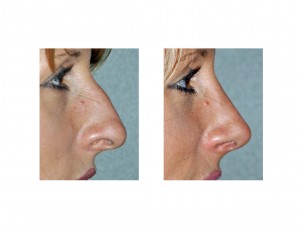
In the June issue of the JAMA Facial Plastic Surgery Journal, an article was published entitled ‘Population-Based Assessment of Currently Proposed Ideals of Nasal Tip Projection and Rotation in Young Women’. In this study, side view pictures were taken of young women between 18 and 25 years of age. Each picture was digitally assessed and modified with nasolabial angles of 96 degrees to 116 degrees at 5 degree increments. The pictures were then assessed for attractiveness by a variety of social groups. The most preferred nasolabial angle was found to be 106 degrees with a Crumley 1 tip projection. This angle was particularly preferred in faces that were considered to have above average attractiveness.
The nasolabial angle along with nasal tip projection are considered two of the most important side profile features of the nose. The nasolabial angle is straightforward to determine. When it is open too far, the nose can look short with too much nostril show. When it is too closed, the nose looks long and droops down
Nasal tip projection is somewhat less clear and has been traditionally defined as the distance along a perpendicular line from the vertical facial plane to the most anterior projecting point of the nasal tip. When there is too much tip projection, the nose looks long and out of balance with the rest of the face.
But there is an intimate relationship between nasal tip projection and rotation. A nose that is too long, even with a desirable nasolabial angle, will still not look good. Conversely, a short nose with too much or too little of a nasolabial angle will look even shorter.
While these nasal measurements along with many others can not always be replicated with certainty during rhinoplasty surgery, they serve as good guidelines to follow.
Dr. Barry Eppley
Indianapolis, Indiana


